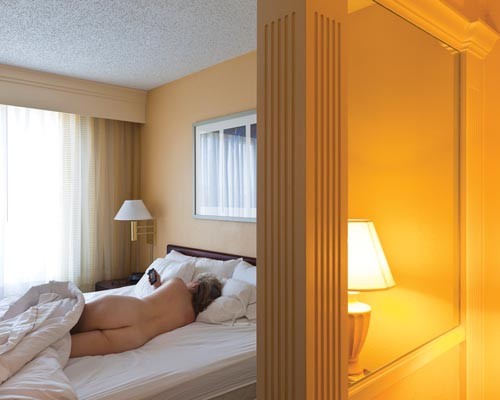Many people fear dying alone. The palliative-care initiative called No One Dies Alone offers a solution by keeping vigil at a patient's bedside. In Lori Waselchuk's black-and-white photograph called "George Checks Jimmie's Breathing," a hand rests gently on the chest of a dying man. This could be a scene from any hospital, nursing home or hospice across the country. But it isn't. This is Angola state penitentiary, Louisiana's maximum-security prison. Here a group of inmate volunteers runs a hospice program to give fellow prisoners comfort and companionship in their final days.
Waselchuk's documentary image opens the exhibition Keystone.1, an inaugural photography biennial at Silver Eye Center for Photography. Described by its curator, Ellen Fleurov, as "the only exhibition of its kind in the state," it highlights the talent of photographers living and working in Pennsylvania. Fleurov selected 16 artists from a total of 40 suggested to her by other art professionals in the state. The works included demonstrate a variety of styles and processes used by contemporary photographers.
While Waselchuk employs a more traditional documentary style, several artists included exploit the tenuous veracity of the photographic image. In Nadine Rovner's "Sara and Justin," a couple sits at a booth in an empty diner. Like the figures in Edward Hopper's painting "Nighthawks," her subjects appear melancholic, alienated and weary, each lost in his or her own thoughts. Rovner's image is clearly staged. It functions like a film still or an advertisement that captures only a fleeting moment in an enigmatic story. So too does Pittsburgh-based Dennis Marsico's "A Dream You Dream Alone Is Only a Dream." In this image, a nude lies on a bed with her back to the viewer, gazing at her cell phone. As with Rovner's characters, this woman is playing a role in an indeterminate narrative. Sarah Stolfa's images are also ambiguous. In them, people navigate hazardous landscapes as if in dreams. In "Glendale, TX," a man stands on scorched earth staring into the middle distance, a singed blanket draped over his shoulder.
While these artists explore the boundaries of truth and fiction, others experiment with the allegorical possibilities of portraiture. Lydia Panas' four portraits from her series "Falling From Grace" depict individuals looking straight at the camera against a black background, each holding an item of food. By giving her subjects props, Panas conveys intimacy and vulnerability through gesture and expression. Donald E. Camp also experiments with portraiture. His "Woman Who Cooks/Chef Lea Chase" and "The Acrobat/Michael" show only his subjects' countenances up close. Using a unique photographic process, Camp produces a haunting surface quality that brings out the details of facial features through light and shadow. Camp's approach, while unquestionably portraiture, borders on abstraction.
Abstraction is present throughout the exhibition. While rooted in reality, Pittsburgh's Robert Raczka uses cropping, color and focus to explore the boundaries of representation and abstraction in his two untitled works. In "Pull," Edward McHugh does the same by obscuring a realistic landscape with a wax surface. Manipulating time exposure in "Chimney Corner #2," Vicki DaSilva also obfuscates a naturalistic scene, covering a dunescape with wide blue bands of undulating light.
Amy Stevens offers a more whimsical look at landscape and abstraction. "Confections (abroad) #1" is a study in color and pattern. She has photographed cakes shaped and decorated like green hills against a backdrop of photographs of real hills backed by cloudy blue skies. Less manipulated but nonetheless surreal is Pittsburgh-based Dylan Vitone's wide-format panoramic print "Looking at the Bear, Yellowstone National Park." While still representational, this piece plays with perspective such that space and perception are distorted.
Made with light but without a physical camera, Nicki Stager's "Spine" is the only truly abstract piece in the exhibition. As a counterpoint, William Larson's "Dick Tracy" -- an archival pigment print incorporating frames from the 1945 movie -- is both an ode to the mechanics of the photographic medium and a consideration of the relationship between the still image and the motion picture. Meanwhile, Pittsburgher Lori Hepner's "There Is No Evidence" explores the nuances of digital code in pieces that spell out words and phrases using barely legible letters floating in petri dishes. It's a fitting theme, as photography becomes a predominantly electronic medium.
The addition of Jeffrey Stockbridge's image of an abandoned interior, and Amie Potsic's conceptual meditation on global politics, rounds out the exhibition with more socially conscious work. In its entirety, this diverse group of photographs offers a unique view of the myriad ways contemporary photographers approach their medium today.
Keystone.1: Pennsylvania Photography Biennial continues through Aug. 27. Silver Eye Center for Photography, 1015 E. Carson St., South Side. 412-431-1810 or www.silvereye.org















